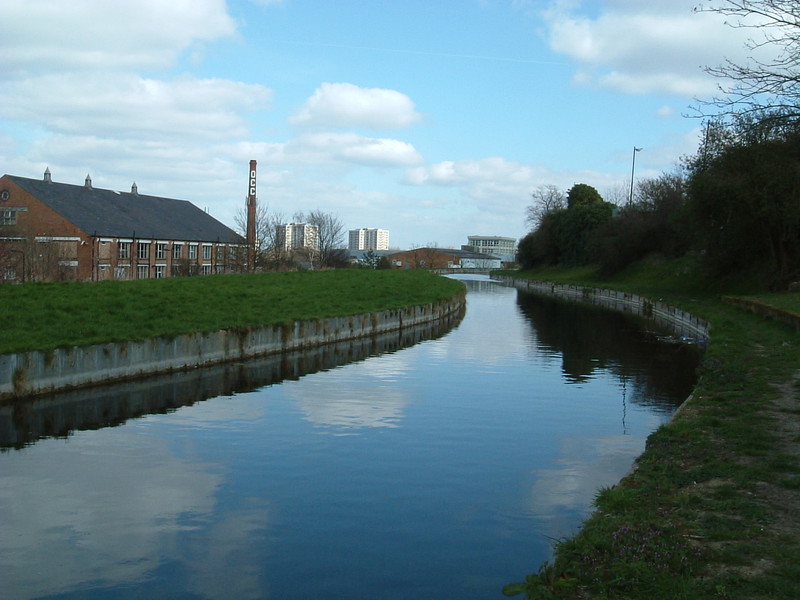
Almost all of this day's walk slopes gently downhill along wide and flat pathways, which is a good thing as the route has been considerably extended since the publication of the first edition of the Capital Ring guidebook in 2003. There was a new edition published in 2006, so presumably the extension is included in there, but luckily the way markers on this leg are up to the usual high standards of the Ring (day 9 aside), so even with the old guidebook, it's easy enough to follow and is well worth the effort.
Anyway, the extension doesn't kick in until the second half of the walk, so let's start at the beginning, halfway along a suburban street in Highgate, where the Ring heads up a steep staircase to the main road before turning onto Archway Road. It's worth taking a pause here to spy out the Archway, a huge bridge down the main road that gives the road (and the nearby tube station) its name. That done, it's time for the Parkland Walk.

I like disused railway lines, because they always make for easy and tranquil walking. The Ring follows the Parkland Walk for two miles along this old section of the Great Northern Railway, and although you can feel London on either side, the embankments and cuttings create a quiet and sheltered stroll that feels surprisingly cut off from the urban sprawl. From the high points you can spy into people's back gardens and enjoy views across to Canary Wharf, and in the cuttings the noise levels are so low you could kid yourself that you're in the countryside. It's a great little track, this.
About halfway along the walk are the old platforms of Crouch End station, and it's the first point at which this feels like a disused railway; it's a strange feeling, walking between the platforms where the trains used to run. But just beyond the old station is the strangest section of all, because this is where the graffiti artists have taken over. Nearby is Crouch Hill Community Centre, which might have something to do with it, but thankfully the artists of Crouch End are really rather skilled, and if you can ignore the amateur tag-scribbling surrounding them, it's worth picking out the amazing designs that dominate the walls. If all graffiti was like this, it would be much easier to be sympathetic to it as an art form rather than a blight.
Finsbury Park

The graffiti dies out as quickly as the cutting walls end, and the Ring dives straight back into the enjoyable plodding of the disused railway, all the way to the gates of Finsbury Park. A large, landscaped park, Finsbury Park is great: it's got a large boating pond, a café, playing fields and, when I visited, a fun fair. As a place to sit and munch on your sandwiches while watching the city tick by, it's great, and it's large enough for plenty of privacy, if that's your thing.
This is where the Ring has been extended, too. The original route – which is still shown on the signs as an option for those who want to avoid steps – follows roads all the way to Clissold Park in Stoke Newington, but the new route takes the New River Path to within a block of Clissold Park, and it's a great improvement. The New River was built in 1613 to bring fresh water to London from Ware in Hertfordshire, 40 miles away, and it was built to follow the contours all the way, dropping an average of two inches every mile, so the water flows without the need for pumps. The river meanders around in an elongated 'S' shape, passing along the northern shores of two reservoirs, the imaginatively named West and East Reservoirs. The views over north London from the banks are excellent, and despite the large number of flying insects who call this part of the world home, it's an enjoyable diversion.

The river peters out not far from the large towers of the Castle Climbing Centre, and it's a stone's throw to Clissold Park, a delightful park that takes the Ring to Stoke Newington. Dominating the green grass and pleasant ponds of Clissold Park is the 220 ft spire of St Mary's Church, and the Ring plods through the park towards this amazing landmark, sitting there on Stoke Newington Church Street. This is a great street: Stoke Newington has always been associated with dissenters and radicals, and modern Stokey retains a similarly bohemian and multicultural atmosphere. Book shops spill out into the street, a dentist operates from a building that looks like the Old Curiosity Shop, cafés set up shop on the pavement, and further on, on the High Street, Stoke Newington feels like another country (something I mean as a compliment). Shops sell things in strange alphabets and smells waft out onto the street that you've never smelled before. It's invigorating.
But before the delights of the High Street, there's an even more amazing treat in store for walkers of the Ring, as it passes through Abney Park Cemetery. This cemetery of 300,000 graves is also an official nature reserve, and the sight of Mother Nature slowly reclaiming thousands of gravestones is a sight to behold. Creepers pull angels down into the undergrowth, while stone caskets split open, spilling stonework onto their neighbours. It's an eerie but beautiful place, and is the perfect place to end this entertaining and easy walk.